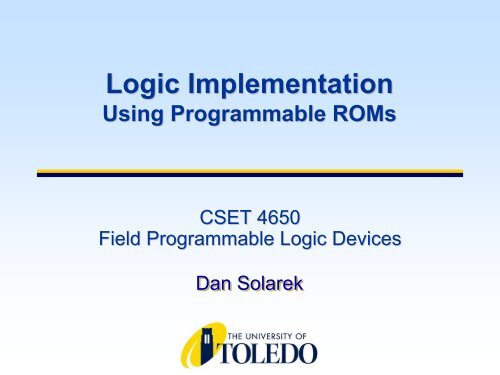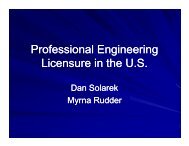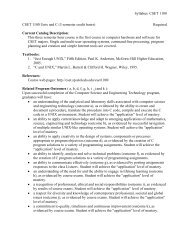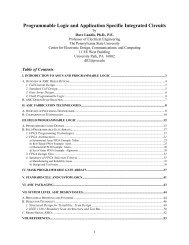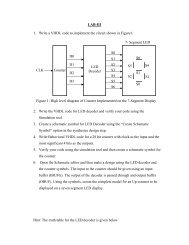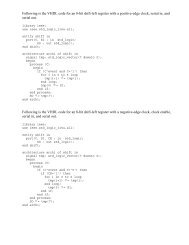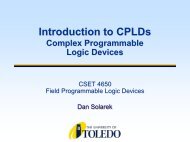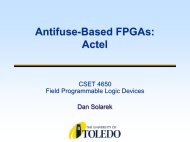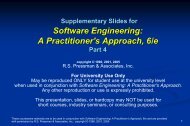Logic Implementation Using Programmable ROMs
Logic Implementation Using Programmable ROMs
Logic Implementation Using Programmable ROMs
You also want an ePaper? Increase the reach of your titles
YUMPU automatically turns print PDFs into web optimized ePapers that Google loves.
<strong>Logic</strong> <strong>Implementation</strong><br />
<strong>Using</strong> <strong>Programmable</strong> <strong>ROMs</strong><br />
CSET 4650<br />
Field <strong>Programmable</strong> <strong>Logic</strong> Devices<br />
Dan Solarek
<strong>Programmable</strong> Read Only Memory<br />
A ROM is a memory device<br />
that holds a fixed, addressable<br />
data set<br />
A PROM may be programmed<br />
by the designer<br />
UV erasable<br />
PROM<br />
2
<strong>Programmable</strong> Read Only Memory<br />
Typical uses include:<br />
Code converters<br />
Character generators<br />
Data storage tables<br />
Program stores<br />
Loaded with tabular data –<br />
not Boolean equations<br />
e.g., a truth table<br />
3
Conceptual PROM Architecture<br />
32x8 PROM<br />
5-to to-32 32<br />
decoder<br />
8 OR gates<br />
with 32 inputs<br />
32x8 internal<br />
programmable<br />
connections<br />
k = 5 2 k = 32<br />
programmable OR connections<br />
output word (8-bits)<br />
4
Conceptual PROM Architecture<br />
A PROM has a fixed AND array (that<br />
decodes the memory address) followed by<br />
a programmable OR array (outputs)<br />
For each of a given set of input<br />
combinations (address), it generates a<br />
multi-bit multi bit value which has been<br />
programmed into the device<br />
5
<strong>Using</strong> P<strong>ROMs</strong> as PLDs<br />
The output functions need to be expressed<br />
in canonical minterm form for PROM<br />
implementation<br />
every input variable appears in each product<br />
term in its true or inverted form<br />
Each minterm is used to represent an<br />
address<br />
Each address generates a multi-bit multi bit output<br />
6
Realistic PROM Architecture<br />
A PROM has a fixed AND<br />
array and a programmable<br />
OR array<br />
Remember, we are only<br />
programming the<br />
CONNECTIONS to the<br />
OR gates<br />
AND gate connections are<br />
all possible combinations<br />
decoder logic<br />
7
Simplified PROM Architecture<br />
Inputs A and B<br />
true and inverted<br />
Outputs Y and Z<br />
e.g., two functions<br />
<strong>Programmable</strong><br />
connections to OR<br />
gates<br />
0 0<br />
0 1<br />
1 0<br />
1 1<br />
8
Example 7-11 7 11 from Sandige<br />
Binary to hex character<br />
generator<br />
<strong>Using</strong> a seven-segment<br />
seven segment<br />
display device and the<br />
character scheme at right<br />
OE<br />
OF<br />
OC<br />
OA<br />
OG<br />
OD OB<br />
9


